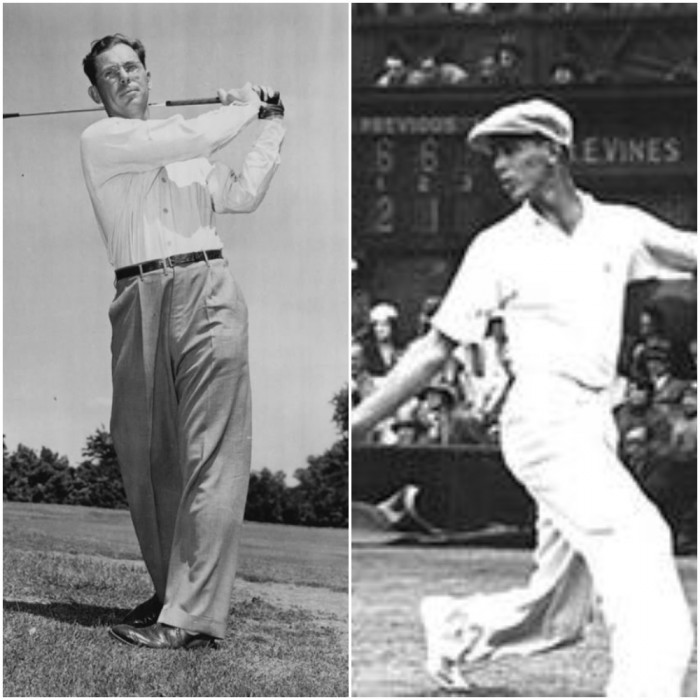by Steve Pratt
Imagine finishing up a round of 18 holes of golf and drifting into the pro shop or clubhouse for a refreshing lemonade and catching up with the local golf pro, never realizing he was once one of the greatest tennis players in the world.
For years that was the case for hundreds of golfers – and even tennis players – who would say hello to Ellsworth Vines, the longtime golf pro at the Tamarisk Country Club in Rancho Mirage starting in 1954 and later at La Quinta Country Club.
That’s the way the tennis legend’s son Henry Ellsworth Vines III tells it. Now 70 years old, the Orange Hills resident Vines doesn’t get asked much about his father these days. Adopted along with his sister as infants, Ellsworth does tell those who do ask about his father being the only athlete in history to play in both Wimbledon in tennis and The Masters in golf , which he did as a top 10 golfer in the world following his tennis career.
“Most people there at his club never knew he played tennis,” said Vines, who is a CPA attorney who still practices business, contract and tax law out of his home. “It wasn’t even that. They didn’t even know he played on the PGA Tour. He just didn’t talk about it. He was very, very, very humble.”
Vines said after former Presidents who would retire to the desert like Dwight D. Eisenhower and Gerald Ford, they would call and play with his father. “But not because he was the local pro, but because they knew his history, and he was just a very likable guy.”
When asked what memories stick out to him involving his father and talking about winning back-to-back U.S. Nationals in 1931 (at age 19) and 1932 and Wimbledon in 1932 and playing in the Masters, Vines goes silent before saying: “The thing that sticks out to me,” he said. “Is that he never talked about it.”
What’s even more remarkable about the South Pasadena native Vines’ career is that tennis wasn’t his first love – or even his favorite sport. An exceptional athlete, Vines played semipro baseball and attended USC on a basketball scholarship.
“He went to USC on a basketball scholarship and won the U.S. Nationals at 19,” Vines said. “But they wouldn’t allow freshman to play on the team. He never ended up playing on the tennis team and there is no record of him ever playing on the basketball team. When he won Wimbledon and the US Open he didn’t get any money because they didn’t pay the amateurs. When he went back to USC he had to work in a bakery.”
When the tennis star Vines was a young boy, his father left his family, leaving the younger Vines to take care of his mother and younger brother.
“His father would come and visit him, but he started another family and ended up becoming a millionaire up in Washington, but didn’t send any money home,” Vines said. “He was in sales for meat packaging stores and opened meat and grocery stores in the Bellingham area.
“(My dad) had a chip on his shoulder and wanted to help his mom and brother get out of poverty and he wanted to get married and support a wife so he just had all that drive to do that well.”
Vines was the owner of what some have called the biggest weapon in tennis history – a booming flat serve. Historian Bud Collins described it this way: “(Vines) had a curious windmill stroke in which the racket made an almost 360-degree sweep. Starting on high as though he were going to serve, he brought the racket back almost to the ground and swept up to the ball. He put no spin on it, however, thereby hitting a flat shot with tremendous force that made him unbeatable when he was on.”
In his 1979 autobiography, Jack Kramer called Vines one of the best ever. “…On his best days, Vines played the best tennis ever. Hell, when Elly was on, you’d be lucky to get your racket on the ball once you served it,” Kramer wrote.
Vines said the reason his father was able to develop such a powerful serve was that he broke his arm at age 14 slipping on a pool deck where he was serving as a lifeguard. The family couldn’t afford to get it fixed, and the break never set properly making his right arm much stronger than his left.
Vines was Kramer’s inspiration to pick up the game of tennis as he first saw him play at the Pomona Fairgrounds in 1935 during his barnstorming tour with Don Budge. He also had tours with Bill Tilden and Fred Perry before becoming bored with tennis and turning to golf in 1942.
Much of the history Vines has learned about his father came from hundreds of love letters he would send his future wife while traveling. Vines even published a book with the contents of the letters after his parents passed on. “He was a very prolific letter writer,” Vines said. “He wrote more when they were dating and he was apart from her. She was able to travel with him more once they got married in the 1930s.”
In 1994, one of Southern California’s top champions died at the age 84.

